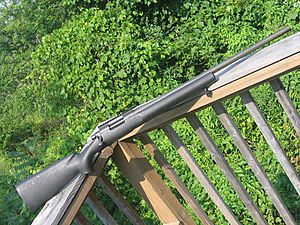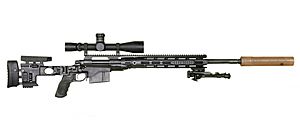Remington Model 700 facts for kids
The Remington Model 700 is a very popular type of rifle that has been made by Remington Arms since 1962. It's a special kind of rifle called a bolt action rifle. This means you have to manually pull a handle (the bolt) back and forth to load a new bullet after each shot.
The Model 700 was created from older Remington rifles, like the Remington 721 and 722. It became so reliable and accurate that even the US Army and Marine Corps use versions of it as sniper rifles. These military versions are known as the M24 and M40.
Remington 700 rifles can hold bullets in an internal magazine, which is usually hidden inside the rifle. Some versions have a hinged plate to unload bullets quickly. You can also get versions with a detachable magazine, which you can remove easily. This rifle comes in many different styles, with various types of stocks (the part you hold) and barrels, and can shoot many different kinds of bullets.
Quick facts for kids Remington 700 |
|
|---|---|
| Type | Bolt action rifle |
| Place of origin | United States |
| Service history | |
| Used by | See Users |
| Production history | |
| Manufacturer | Remington Arms |
| Produced | 1962–present |
| No. built | over 5 million |
| Specifications | |
| Mass | 8.99 lb (4.08 kg) |
| Length | 41.5 in (1,050 mm) |
| Barrel length | 16.5 to 26 in (420 to 660 mm) |
|
|
|
| Cartridge |
|
| Action | Bolt action, rotating bolt with 2 lugs |
| Feed system | 3- to 6-round internal magazine or detachable 10-round magazine |
| Sights | Scope, rail interface system |
Contents
How the Remington 700 Was Made
After World War II, an engineer named Mike Walker at Remington Arms wanted to design rifles that were cheaper to make. He started with the Model 721. This rifle used a round metal piece for its main body, which was easier to shape than older designs. This helped lower the cost of making the rifles.
Over time, Walker and his team kept improving this design. This led to the Model 722, Model 725, and finally, in 1962, the famous Model 700. Walker wanted these new rifles to be very accurate. He made sure the parts were built precisely and that the rifle fired very quickly after the trigger was pulled.
Remington first made two main types of the Model 700: the ADL and BDL. These came in different sizes to fit various types of bullets. In 1969, the company added some upgrades, like a longer bolt cover and better stock finishes. A few years later, they even started making versions for left-handed shooters.
The Model 700 became popular not just for hunting, but also for military and police use. The United States Marine Corps ordered the M40 rifle in 1966, which was based on the Model 700. Later, the US Army adopted the M24 Sniper Weapon System in 1986, also built from the Model 700.
How the Design Works
The Remington 700 is a bolt action rifle. This means you operate it by hand. It has a special bolt with two locking parts that hold the bullet firmly in place when you shoot. The bolt also has a small clip that pulls the empty shell out after firing.
The main body of the rifle, called the receiver, is made from a round piece of steel. This makes it strong and easy to produce.
The Remington 700 comes in many different versions. It has a bolt that is about 0.695 inches (17.7 mm) wide. There are two main sizes for the rifle's action:
- Long action: This is for longer bullets, like the .30-06 Springfield or powerful magnum bullets. It takes about 3.0 to 3.2 milliseconds for the firing pin to hit the bullet.
- Short action: This is for shorter bullets, like the .308 Winchester. It's a bit faster, taking about 2.6 milliseconds.
You can also find different ways to hold the bullets. Some have a "blind magazine" with no opening at the bottom. Others have a traditional magazine with a removable bottom plate. And some use a detachable box magazine that you can take out completely.
Standard Models of the 700
Remington makes many standard versions of the Model 700. For example, the Mountain LSS model has a special stainless steel barrel and a strong laminated wood stock. There are also "varmint" versions, like the Model 700 SPS Varmint, which have heavier barrels. These are designed for very accurate shooting, often for hunting small animals called varmints.
The Model 700 SPS (Special Purpose Synthetic) replaced the older ADL model as the most affordable version. It usually comes with a synthetic (plastic) stock.
Remington also tried some unique versions, like the 700 ML, which was a muzzleloading rifle (where you load the bullet from the front of the barrel). They even made a Model 700 EtronX with an electronic firing system, but it wasn't very popular and stopped being made.
Remington 700P: The Police Version
Remington sells a special version of the Model 700 to police and military groups. This version is called the Model 700P, which stands for "Police."
The 700P is designed to be very accurate and strong, similar to the military sniper rifles. One key feature is its heavier and thicker barrel. This helps make it more accurate and reduces the kick (recoil) when fired. It can shoot many different types of bullets, including the popular .308 Winchester and .223 Remington.
The 700P usually has a 26-inch barrel and a special stock made by HS Precision, which helps improve its accuracy. Even though it's designed for police, Remington also sells the 700P to the public. Sometimes, you can even buy it with the same scope that the U.S. Army uses on its M24 sniper rifle.
Remington 700: The Military Version
Both the U.S. Army's M24 Sniper Weapon System and the U.S. Marine Corps' M40 sniper rifles are built using the Remington Model 700. These military rifles are modified with special heavy barrels and other features to make them extremely accurate.
The main difference between the M24 and M40 is the length of their main body (action). The M24 uses a "long action" because it was originally designed to shoot longer, more powerful bullets like the .300 Winchester Magnum. The M40 uses a "short action."
The U.S. Army decided to upgrade its M24 sniper rifles to make them even more powerful. They awarded a contract to Remington to change up to 3,600 M24 rifles. These upgrades would change the rifle to shoot the more powerful .300 Winchester Magnum bullet, giving soldiers more range and precision. This upgraded rifle was later named the XM2010 Enhanced Sniper Rifle.
Remington Model Seven
The Remington Model Seven is a smaller, more compact version of the Remington 700. It's designed to be a carbine, which is a shorter rifle. It uses a "short action" and is often chambered for bullets like the .223 Remington and .308 Winchester. It was first introduced in 1983. The Model Seven has a shorter stock and a barrel that is only 18.5 inches long, making it easier to carry and handle in tight spaces.
Users
The Remington Model 700 is used by many different groups around the world, including:
 Australia: New South Wales Police Force
Australia: New South Wales Police Force Canada: Royal Canadian Mounted Police (RCMP)
Canada: Royal Canadian Mounted Police (RCMP) China: People's Armed Police
China: People's Armed Police Indonesia: Special forces groups like Kopaska and Kopassus
Indonesia: Special forces groups like Kopaska and Kopassus Israel: Israeli Police and special forces (though some have been replaced)
Israel: Israeli Police and special forces (though some have been replaced) Malaysia: Pasukan Gerakan Khas (PGK)
Malaysia: Pasukan Gerakan Khas (PGK) Philippines: Philippine Marine Corps (PMC)
Philippines: Philippine Marine Corps (PMC) Sierra Leone: Sierra Leone Police
Sierra Leone: Sierra Leone Police United States: U.S. Border Patrol, United States Marine Corps, United States Navy, United States Army, and some police departments.
United States: U.S. Border Patrol, United States Marine Corps, United States Navy, United States Army, and some police departments. Ukraine: Ukrainian Army
Ukraine: Ukrainian Army
See also
 In Spanish: Remington 700 para niños
In Spanish: Remington 700 para niños
- List of firearms
- List of rifle cartridges
- Table of handgun and rifle cartridges





